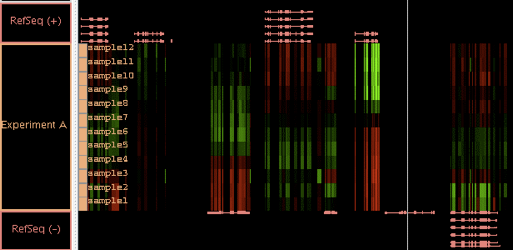Introduction
IGB allows you to manipulate graph tracks in multiple ways, both by transforming an individual track or by combining two graph tracks in a mathematical way. Controls for transforming and combining graphs can be found in the Graph Adjuster tab.
Transforming
By default, all graphs display in linear scale, but IGB allows you the option to transform a graph into other scales. Select the graph(s) and open the Graph Adjuster tab. Select the type of transformation you would like to perform from the pull-down menu labeled Transform, then click GO. The picture below includes all of the options available (but also includes Natural Log).
IGB duplicates your graph in a new track and applies the selected scale to the new graph; your original graph is not deleted. Note that one of the choices of scale is Copy, which makes a copy of the graph without any transformation. That can be useful if you want to explore the effects of showing one graph in two graph styles at the same time.
Duplicating graphs
You may want to duplicate a graph to experiment with different graph adjustments without losing adjustments that you have already made.
To duplicate a graph:
- Click the colored bar at the left end of a graph to select it.
- Click the Graph Adjuster tab. In the Advanced section, under the label Transformation select Copy and click Go.
Joining and splitting graphs
It is possible to join two or more graphs into a single annotation track. The two graphs will then have a single track tier label and can be moved and adjusted as a group.
To join multiple graphs, select them, then press the Join button in the Advanced portion of the Graph Adjuster panel. To separate graphs that were earlier joined together in this way, select them and press the Split button.
When the tier is in the expanded state, the multiple graphs are shown in separate non-overlapping bands:
If the tier is collapsed, all graphs are shown in the same, overlapping band:
When joined graphs are collapsed, any opaque regions of the top graph will hide corresponding features of the lower graph or graphs.
Joining graphs into a single annotation track can be very useful for expression data from multiple experiments. Here, data from several experiments at different times during the development of an organism are shown together in a single track, and it is easy to see that expression of genes is being regulated over time.
By selecting the single tier label, here labeled "Experiment A", you can easily set the graph style and data range for all these graphs to be identical.
Graph arithmetic
You may need to compare the relative differences in expression levels between two graphs that represent data that occupy the identical genomic position on the chromosome. For example, a graph of cancerous cells will show what's turned on or off when compared to a graph of normal cells. Results that show significantly more or less activity than a control graph for the same region may indicate an area of interest.
Arithmetically combining two graphs may make the differences and correlations easier to see.
To arithmetically combine two graphs:
- Shift-click the bar at the left end of each graph to select the graph. The graph you click first is A, the graph you click second is B.
- Use one of the four Combine buttons in the Advanced portion of the Graph Adjuster tab labeled A+B, A-B, A*B, and A/B.
- Alternatively, right-click the bar at the left end of either graph and choose Combine Graphs, then choose one of the following:
- Create Sum Graph (A+B)
- Create Difference Graph (A-B)
- Create Product Graph (A*B)
- Create Ratio Graph (A/B)




